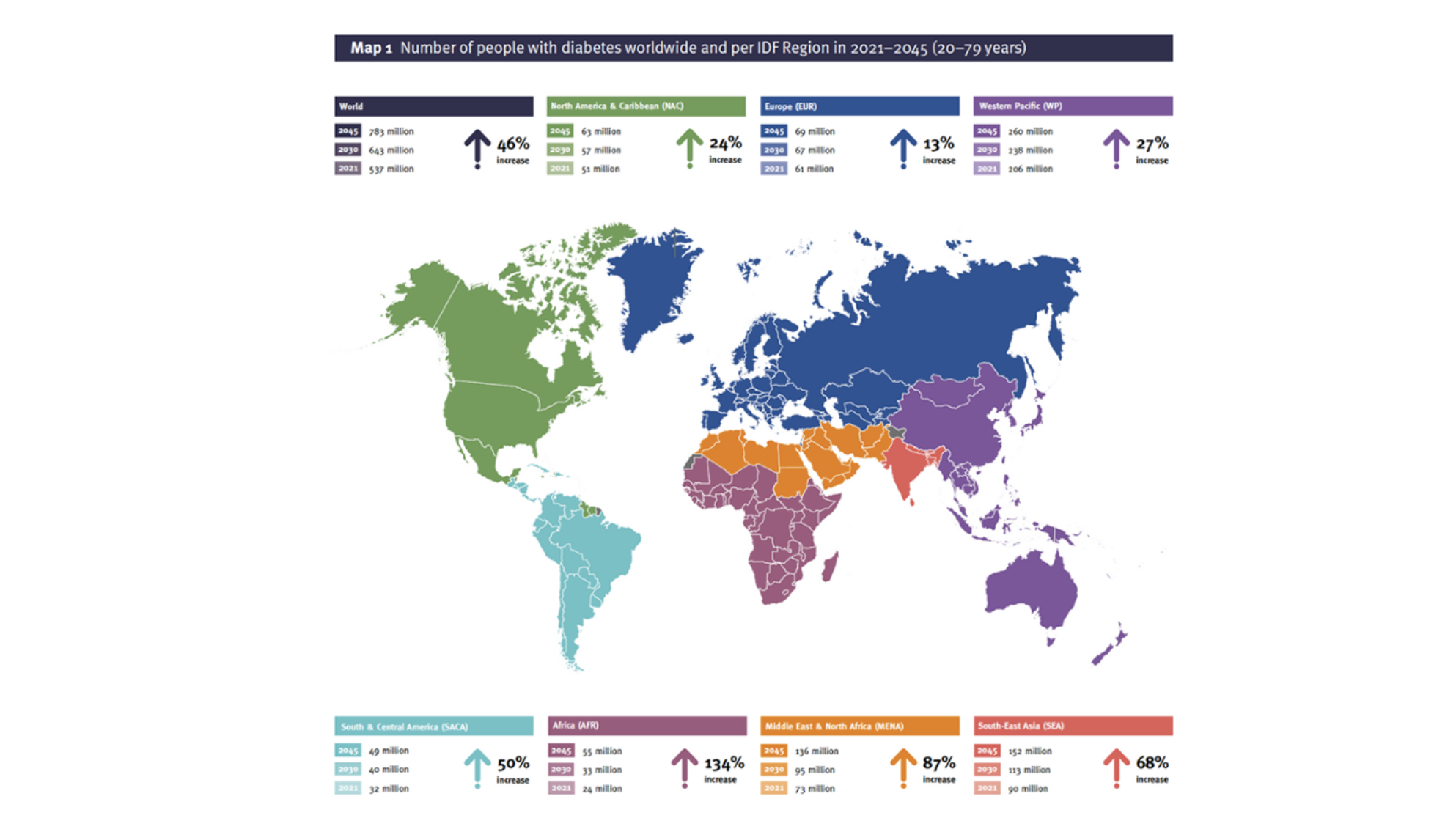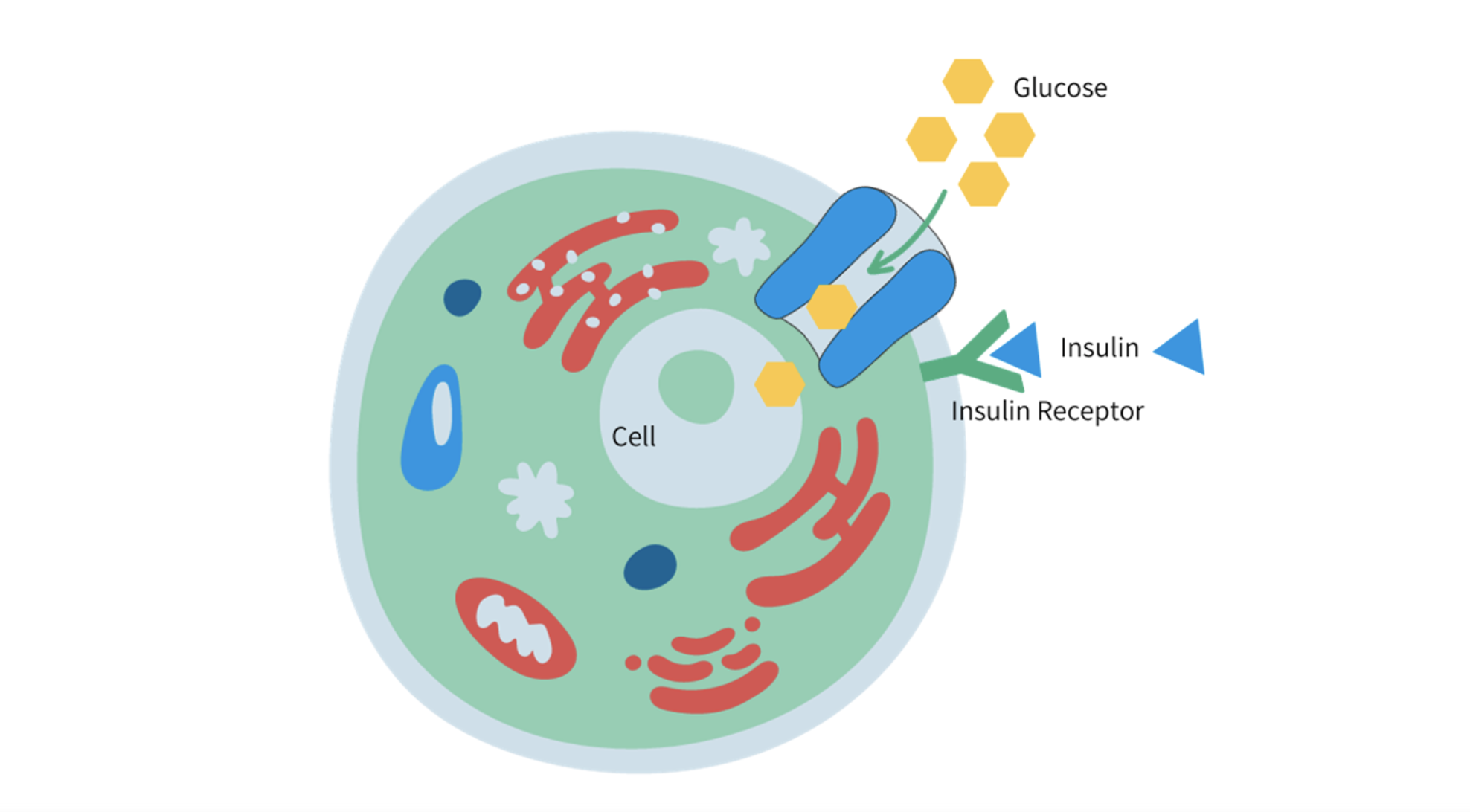Type 2 Diabetes: You Can Reverse It
By Terri Chrisman M.Nutr, Dip.ACLM from the PAN Academy – our online learning platform where you can learn all about nutrition and health.
The world is in the grip of a diabetes epidemic. In 2023, 537 million people are suffering from diabetes, and by 2045 that number is expected to swell to over 700 million people (1). Type 2 diabetes affects people disproportionately. People from lower-income countries are affected more than those from more affluent nations (1).
Half of the people with diabetes don’t even know it (1). This is very dangerous. If left unchecked, diabetes can be fatal. Diabetes is a progressive, debilitating disease that can result in blindness, nerve damage that leads to limb amputation, and finally death.
Image: World Diabetes Atlas, 2021
There are many forms of diabetes, and in this article, we are going to focus on type 2 diabetes (T2D). T2D represents 90-95% of all diabetes cases worldwide (1). We will discuss the other types of diabetes; type 1 diabetes, gestational diabetes, maturity-onset of diabetes in the young (MODY) and latent autoimmune diabetes in adults (LADA), in subsequent articles.
So, what is T2D, and what can we do to prevent it? To fully understand what goes wrong in the human body to cause diabetes, first, we need to understand normal glucose metabolism.
Normal glucose metabolism
The human body loves glucose! Glucose is the body’s preferred fuel source. Every time we eat food, the body breaks down the carbohydrates into individual glucose molecules and uses them for energy. If we don’t eat any carbohydrates, the body will use glycogen, which is a form of glucose stored in the liver and muscles. If the body is depleted of glycogen, it will convert fat and muscle tissue to use as fuel instead.
After digestion, glucose enters the bloodstream. This rise in blood glucose signals the beta cells of the pancreas to produce the hormone, insulin.
Insulin is like a key to a lock. Its job is to help the glucose enter the body’s cells so that it can be converted to energy. Only the insulin key can open the door of the cell to allow the glucose inside. Some glucose is also absorbed by the liver to create glycogen, some is stored in the muscles or used by the muscles for energy, and some is converted to fatty acids and stored as triglycerides in fat cells.
Progression of Type 2 Diabetes
When a person has T2D, the insulin is unable to assist the glucose into the cell. This is termed insulin resistance and results in high circulating blood glucose. If the muscle cells cannot absorb glucose for energy, the body thinks it is glucose deficient so it starts making its own glucose. The pancreas stops producing insulin. The liver starts converting glycogen back to glucose. This further exacerbates the problem of elevated blood glucose. Elevated blood glucose is called hyperglycaemia (hyper = excessive + glycaemia = glucose in the blood). Hyperglycaemia can cause the trademark symptoms of diabetes: sudden weight loss, fatigue, excessive thirst and excessive urination.
At the same time, fat accumulation within the pancreas can cause a progressive decrease in insulin production. It’s a double-edged sword: there’s not enough insulin to clear the glucose, and the insulin that is in the blood, is not doing its job correctly.
Extended periods of high concentrations of blood glucose can cause hypertension (high blood pressure), retinopathy (eye disease) nephropathy (kidney disease), cardiovascular disease and neuropathy (nerve damage)(2).
What causes diabetes?
So, why can’t insulin help the glucose into the cell? Remember that insulin is like a key to a lock? In the case of diabetes, the lock is jammed, and the door to the cell won’t open.
Obesity is one of the main precursors to insulin resistance and T2D. About 90% of people with T2D are overweight (3). Being obese, with a body mass index (BMI) of >35 kg/m2 increases the risk of developing diabetes over 10 years by 80 times. Compared to people of a healthy weight, people with obesity have increased insulin resistance, increased liver glucose production, and increased circulating free fatty acids (FFA). Obesity causes chronic inflammation, that can lead to insulin resistance and beta cell dysfunction (4).
Genetic factors can play a role in the development of T2D (5). Diabetes is more prevalent in Pacific Islanders, African Americans, Hispanic and Asian populations than in Caucasians. Whilst only 10-15% of T2D is attributed to genetic influences (6), having a genetic predisposition for diabetes does not dictate our future. How we live our lives is far more important.
How do we avoid developing diabetes?
If genetics account for 10-15% of the risk of developing diabetes, that means that up to 90% is up to us. The greatest non-genetic risk factors for developing diabetes are obesity, having gestational diabetes when pregnant, and lack of exercise (7). Reducing body fat by 7% can prevent the onset of T2D and is as effective as drug therapy for those already with T2D (8).
The key to weight loss is reducing caloric intake. In a 2018 UK study assessing the effect of weight loss on patients with T2D, 86% of participants who lost 15 kg achieved full remission of their diabetes (9). None of the participants who gained weight achieved remission.
Losing weight is a complex and often stressful process, but it doesn’t have to be that way. Removing high-calorie-dense foods such as ultra-processed foods, fried foods and foods containing animal products from our diets can dramatically lower the number of calories we consume.
The Solution
Luckily, there is a simple solution. A whole food plant-based diet consisting of whole grains, fruit, vegetables, and legumes is naturally low in calories. Eating this way ensures you obtain optimal nutrition, without going hungry, and without missing out on flavour. Apart from lowering the risk of diabetes, eating a whole food plant-based diet lowers the risk of all lifestyle diseases including stroke, heart disease and obesity, ultimately reducing your risk of early death (10).
Not all plant-based diets are the same. Whilst a whole food plant-based diet can reverse disease, a plant-based diet filled with processed plant-based foods and ready meals, ultra-processed meat alternatives, added sugars and fats does not afford the same health benefits (11).
Cooking styles also influence the calorie density of our diets. Frying and sauteing in oil can add many hundreds of calories to an otherwise healthy diet. Boiling, steaming and air-frying allow you to eat as much as you like without the added fat calories. Air-fried potatoes taste just as good as oil-fried potatoes and contain a fraction of the calories.
Practical tips
Aim to keep your weight in the normal range.
See your primary care physician and check your blood glucose levels regularly.
For a healthy way to reduce calorie density and lose weight, switch high-calorie processed foods and animal products out for low-calorie plant foods.
Download our factsheet on Type 2 Diabetes for patients for more practical tips on whole food plant-based eating for diabetes management.
The bottom line
Changing the way you eat can be challenging. Instead of changing everything at once, look for ways to make healthy choices. Add more veggies to your plate. Choose fruit for snacks. Cook more at home. Small actions done consistently can add up to big changes.
Additional Information:
-
Terri Chrisman M.Nutr, Dip.ACLM is a Medical Content Creator at PAN and part of the online education team responsible for the PAN Academy. She is an Australian citizen living in the USA who has travelled and lived all around the world. She is a qualified nutritionist and certified in lifestyle medicine, and is vastly experienced in creating educational content on the topics of nutrition, health and sports.
-
Download our factsheet on Type 2 Diabetes for patients for more practical tips on whole food plant-based eating for diabetes management.
-
International Diabetes Federation, 2021. IDF Diabetes Atlas 2021. Available from: https://diabetesatlas.org/atlas/tenth-edition/
ElSayed et al., 2022. Classification and Diagnosis of Diabetes: Standards of Care in Diabetes—2023. Available from: https://doi.org/10.2337/dc23-S002
Galicia-Garcia et al., 2020. Pathophysiology of Type 2 Diabetes Mellitus. Available from: https://doi.org/10.3390/ijms21176275
Cornell S, 2015. Continual evolution of type 2 diabetes: an update on pathophysiology and emerging treatment options. Available from: https://www.ncbi.nlm.nih.gov/pmc/articles/PMC4404882/
Serjeantson et al., 1983. Genetics of diabetes in Nauru: Effects of foreign admixture, HLA antigens and the insulin-gene-linked polymorphism. Available from: https://doi.org/10.1007/BF00251889
Rathmann et al., 2013. Type 2 Diabetes: Prevalence and Relevance of Genetic and Acquired Factors for Its Prediction. Available from: https://pubmed.ncbi.nlm.nih.gov/23762204/
National Institute of Diabetes and Digestive and Kidney Diseases, 2022. Risk Factors for Type 2 Diabetes. Available from: https://www.niddk.nih.gov/health-information/diabetes/overview/risk-factors-type-2-diabetes
Diabetes Prevention Program, 2002. Reduction in the incidence of type 2 diabetes with lifestyle intervention or Metformin. Available from: https://www.nejm.org/doi/full/10.1056/nejmoa012512
Lean et al., 2018. Primary care-led weight management for remission of type 2 diabetes (DiRECT): an open-label, cluster-randomised trial. Available from: https://www.sciencedirect.com/science/article/pii/S0140673617331021
Kahleova et al., 2017. Cardio-Metabolic Benefits of Plant-Based Diets. Available from: https://www.mdpi.com/2072-6643/9/8/848
Nolden & Forde, 2023. The Nutritional Quality of Plant-Based Foods. Available from: https://www.mdpi.com/2071-1050/15/4/3324





